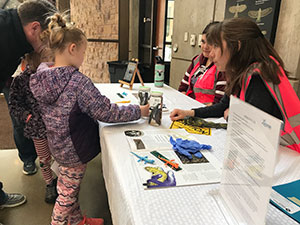
Contact Us
Institutional Communications
Bureau of Mines Building, Room 137
Laramie, WY 82071
Phone: (307) 766-2929
Email: cbaldwin@uwyo.edu
UW Biodiversity Institute to Host Salamander Migration Initiative This Month
Published April 03, 2024

UW’s Biodiversity Institute will host the Laramie Salamander Migration Initiative,
which includes a Salamander Saturday event April 13; identifying salamanders; and
having the public help with salamander Migration Nights during the spring. Here, volunteers
Brett Addis (foreground, right) and Lindsey Mitchell talk with guests about the Laramie
salamander migration during the Salamander Saturday 2023 event. (Mason Lee Photo)
The University of Wyoming’s Biodiversity Institute will put the spotlight on the Western tiger salamander this spring and offer the public opportunities to learn about and help Wyoming’s state amphibian.
The Laramie Salamander Migration Initiative will start with Salamander Saturday from 9-11:30 a.m. April 13 in the Berry Biodiversity Conservation Center. Event partners include the UW Art Museum and the Wyoming Game and Fish Department.
During this free, educational outreach event, the public can participate in arts and crafts activities; stop by information tables to meet the Biodiversity Institute’s ambassador Western tiger salamander; learn about the salamander migration; and speak with Wyoming Game and Fish biologists. These activities will take place from 9-10:30 a.m. in the lobby and second floor of the Berry Center.
Volunteer training and an update on the Migration Nights project will take place from 10:30-11:30 a.m. in the Berry Center auditorium.
“We will provide an update on what we have learned in the last two years of running the Migration Nights project,” says Mason Lee, senior project coordinator in the Biodiversity Institute. “We also will provide training for anybody who wants to help salamanders cross the streets during their migration or report salamander sightings.”
The “Report a Salamander” project is another component of the Salamander Migration Initiative. Citizens are asked to submit reports on salamander sightings in Laramie as well as around the state. Reports of live or dead adult salamanders and larval salamanders are welcome. To submit a report, go here to fill out the requested information.
“These reports have been so helpful to our project, and we appreciate everyone who has sent one in,” Lee says. “We’ve learned when the salamanders in Laramie leave the LaBonte Park pond after metamorphosing because of these reports, and we’ve also found out about another urban population that might be in need of migration assistance.”
During Migration Nights, the third component of the migration initiative, the public is asked to help adult salamanders safely cross the road during their migrations. Each spring, on rainy nights, hundreds of Western tiger salamanders -- taking up residence in the yards of Laramie homes -- find their way to LaBonte Park. To sign up and assist in this effort, go here.
The research team will be stationed at the LaBonte Park covered picnic shelter near Eighth and Canby streets on the “big” migration nights. Researchers will collect information on the sex and size of the salamanders before releasing them, Lee says.
Volunteers should report to the picnic shelter to collect high-visibility safety vests, gloves and buckets. Volunteers will need to wear warm, waterproof clothing and headlamps.
“Any salamanders that are found should be brought to researchers at the picnic shelter. If folks find a salamander on a rainy night when the researchers are not at the picnic shelter, we ask that volunteers move the salamander off the road when it is safe to do so and take a picture and report the information to our ‘Report a Salamander’ page,” Lee says. “We ask folks to walk along the streets near LaBonte or any of the ponds in Laramie, too, to look for salamanders on any rainy spring night and report their sightings.”
Adult tiger salamanders are difficult to find because they spend much of the year underground and, when they are above ground, they are primarily nocturnal. When they reach LaBonte Park, they breed and lay thousands of eggs in the pond. After a few weeks, the eggs will hatch, and small aquatic salamanders emerge. Toward the end of the summer, the tiger salamanders undergo a metamorphosis to become terrestrial adult salamanders. They migrate back to the yards around LaBonte Park, where they spend the rest of the year in underground burrows until the following spring.
For more information about the Laramie Salamander Migration Initiative, email Lee at mlee37@uwyo.edu.
About the University of Wyoming Biodiversity Institute
The UW Biodiversity Institute fosters conservation of biodiversity through scientific discovery, creative dissemination, education and public engagement. In this setting, scientists, citizens, students and educators come together to share a wealth of perspectives on the study and appreciation of biodiversity -- from microbes to poetry and ecosystems to economics. Learn more at www.wyomingbiodiversity.org.
Contact Us
Institutional Communications
Bureau of Mines Building, Room 137
Laramie, WY 82071
Phone: (307) 766-2929
Email: cbaldwin@uwyo.edu
